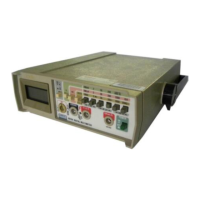ACCESSORIES
PROBE
ACCESSORIES
600-12. OFFSET
AND CENTER MOUNTING
KITS
MOO-200-611
AND MOO-200-612
600-13. Use
the following procedure to install an
Multimeter
using
the center mounting or the
offset
mounting
kit:
1. Remove the
carrying handle
by removing the
handle disc decals and then
the handle
mounting
screws.
2. Remove
the screw from the rear of the case and
remove
the case.
3.
Install the side
mounting
brackets
as shown in
Figure
600-3,
and secure them to the mounting
panel using the
nuts provided.
4.
Insert the front of
the
case through
the opening
on the
back
side
of the mounting
panel.
5.
Replace the handle
mounting
screws
through
the side
brackets into
the mounting
bosses. Do
not
overtighten
these screws.
6.
Slide the
instrument
through the
mounting
panel and into the case.
Replace the
retaining
screw
at
the rear
of the case.
600-1
4. DUAL MOUNTING
KIT MOO-200-61
3
600-15. Use the following
procedure
to
install two
Multimeters,
side-by-side,
using the Dual
Mounting Kit:
1.
Remove
the carrying handles
from both
instruments by removing the handle disc decals
and then
the handle motmting
screws.
2.
Remove the retaining screw
from
the rear of the
cases
and separate
the
instruments
from their
cases.
3. InstaD
the center mounting bracket as shown in
Figure
600,-4
and
secure
it
to
the
mounting
panel
using the nuts provided.
4.
Install the clamp screw in the
center
mounting
bracket using the
nuts
and washers provided.
5.
Insert the front of the instrument cases
through
the
openings on the
back
side of the mounting
panel.
Make
sure the
cases’
handle mounting
bosses
are inserted into
the
clamp hole of the
center
mounting bracket.
6.
Tighten
the clamp screws.
7.
Install
the side
mounting brackets and secure
them to
the
front panel using the nuts provided.
8.
Replace
the
handle
mounting screws through
the
side
brackets into
the handle mounting
bosses.
Do
not
overtighten these screws.
9.
Slide the
instruments through the mounting
panel and into
their cases. Replace the retaining
screw at the rear
of both
cases.
600-16. PROBE
ACCESSORIES
600-17. The
probe accessories
are shown in Figure
600-
5
and
are
described in the following
paragraphs.
Table
600-1 contains
all
applicable specifications for
the
probes.
600-18.
Touch-Hold
Probe
80T-H
600-19. The 80T-H is a
direct signal-through test
probe
with
a touch and hold
feature. Touch and Hold allows
voltage, resistance,
and
conductance readings to be held
on the DMM
display
following the measurement.
This
convenience
promotes
greater
safety because the operator
can
concentrate on
the
placement
of
the
probe and read
the display later. The
Touch
and Hold feature is activated
by a push
button located on
the probe. Pressing this
push
button holds the
present
reading on the DMM display
until
the
push
button is
released.
600-20.
Temperature
Probe, Celsius
80T-150C
600-21.
The 80T-150C
Temperature
Probe converts
your
instrument into a direct-reading
(1
mV
dc/ degree)
Celsius
thermometer. It
is
suited for surface, ambient, and
some liquid measurements. A
rugged,
fast-responding
probe tip
with a 350V dc standoff
capability
makes the
80T-150C a
versatile and easy-to-use
temperature
probe.
600-22.
Temperature
Probe, Fahrenheit 80T-150F
600-23. The
80T-150F
is the as the 80T-150C except the
80T-150F
is set to read in
degrees Fahrenheit.
600-24.
AC
Current Probe
801-400
600-25.
The Model
80i-400 Current Probe extends the
maximum
2A ac current
range
of the Multimeter to 400
A.
The clamp-on, 1000
turn
transformer design allows you
to
measure current
without
breaking the circuit
under
test. The Multimeter
displays
the current measurement as
I
/
1000th
of the actual
current
in the circuit (e.g.,
a
display
reading of 5 mA is
equal to 5 A of current in the circuit.)
600-26.
AC
Current
Probe 801-600
600-27. The Model
801-600
Current
Probe
extends
the
maximum 2A
ac
current measuring limit
of
the
Multimeter
to a
maximum of 600A. The clamp-on
transformer design allows measurements to be made
without
breaking
the circuit under
test. Because of a high-
efficiency, quadrature-type of winding, wire size
and
location
of the
conductor
within the transformerjaws do
not affect the accuracy of the
current
measurement.
600-2

